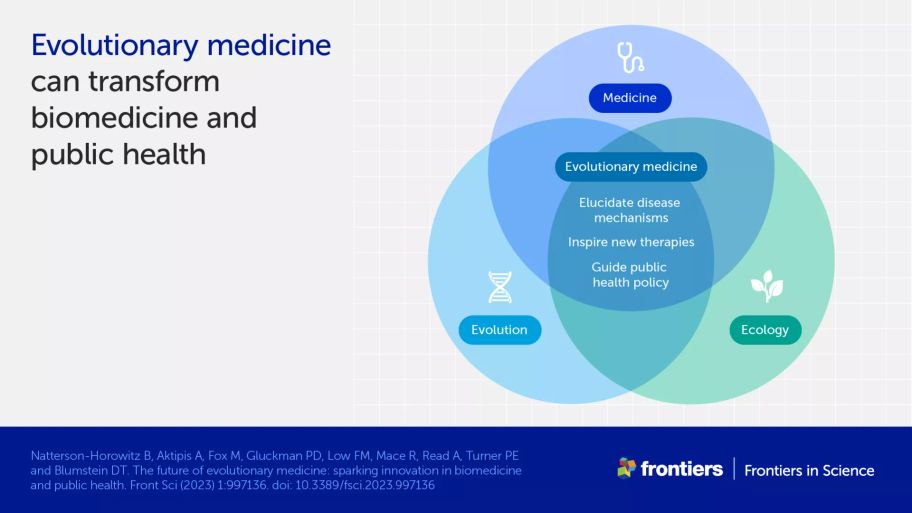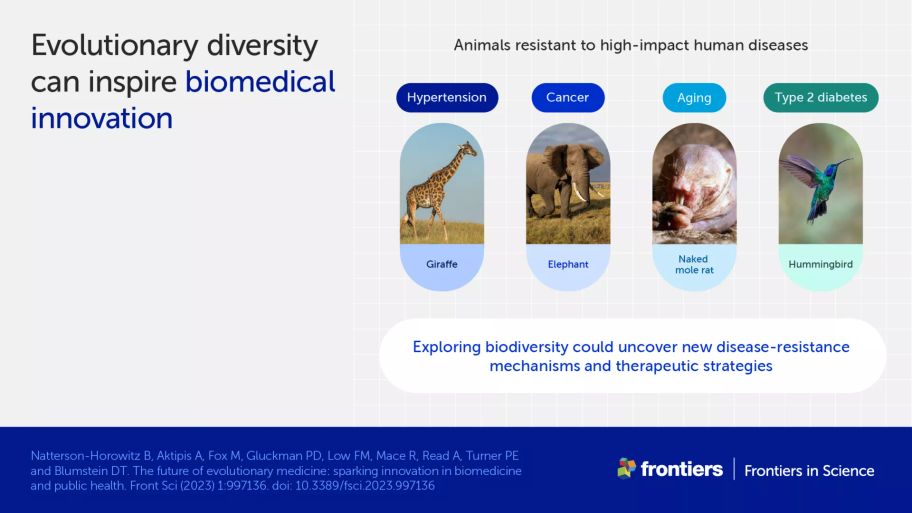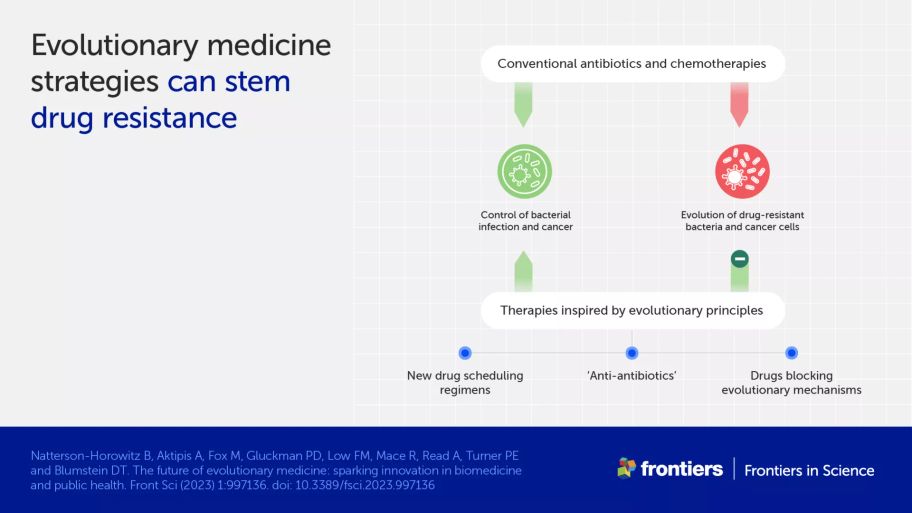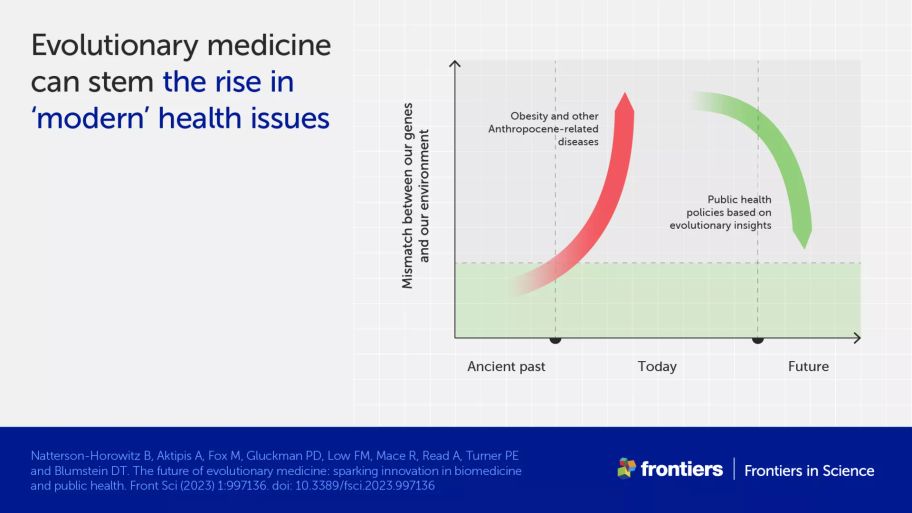The future of evolutionary medicine: sparking innovation in biomedicine and public health
Explainer
Front Sci, 27 February 2023
This explainer is part of an article hub, related to lead article https://doi.org/10.3389/fsci.2023.997136
Transforming biomedicine and public health using evolutionary principles
Evolutionary medicine has tremendous – and as yet unrealized – potential to improve human health and well-being, by informing new biomedical therapies and effective public health measures. We outline a research agenda for the future of evolutionary medicine, focusing on its use to:
find animal species that are naturally resistant to human diseases and leverage these mechanisms into new clinical treatments
overcome drug resistance in infectious diseases and cancer
inform public health policies on how to effectively address diseases stemming from mismatches between the ecologies in which we evolved and today’s world
improve pandemic management
overcome human resistance to health-promoting behaviors.
What is evolutionary medicine?
Evolutionary medicine applies insights from ecology and evolution to inform, direct, and improve biomedical research, public health measures, and clinical care.
Applying an evolutionary perspective would help overcome many critical health challenges. These include the antibiotic resistance crisis, chemotherapy resistance in cancer, modern health issues like obesity, diabetes, and cardiovascular disease – and even people’s resistance to health advice. This approach will also be vital for identifying emerging new pathogens and managing future epidemics and pandemics.

How can evolutionary diversity inspire biomedical therapies?
Traditional biomedical research takes advantage of similarities between humans and other animals to uncover disease mechanisms and develop therapies. But evolutionary medicine also looks to our differences for inspiration. For example, elephants rarely develop cancer while naked mole rats are naturally resistant to age-related diseases and so live unusually long, healthy lives. Countless other disease-resistance mechanisms are likely to exist among the vast diversity of life on Earth. We need to systematically search these out – then uncover their physiological basis and turn these findings into new clinical treatments.

How can evolutionary principles inspire new cancer treatments?
Many cancer therapies aim to eliminate tumors with high doses of anti-cancer drugs. Then, when the treatment is no longer effective, it is replaced by another, and possibly others still. Though this can be successful, it suffers from two critical limitations: the evolution of drug resistance in cancer cells, and toxicity to normal cells. Evolutionary medicine can tackle these hurdles by designing treatments that take cancer cell evolution into account. For example:
extinction therapy proposes a high dose of one drug to reduce the tumor size, followed by another drug to kill off remaining cancer cells before they develop chemotherapy resistance
adaptive therapy aims to stabilize tumor size while keeping the cancer cells sensitive to the drug treatment. This approach shows promise for long-term control of advanced cancers.
How can evolutionary medicine help address the antimicrobial resistance crisis?
Resistance to antimicrobial drugs among bacteria and other infectious microorganisms is a major global health threat. Conventional solutions include the development of new antimicrobials, but this is costly and only offers a temporary solution. Alternative approaches include:
drug combinations, schedules, and dosages that prevent microbes from developing resistance
targeting the evolutionary process itself, for example by interfering with mechanisms by which bacteria share DNA and thereby spread resistance (a process called horizontal gene transfer)
oral ‘anti-antibiotics’, which could prevent antibiotics given intravenously from causing resistance in gut bacteria
using viruses that infect bacteria, called phages, to kill antibiotic-resistant variants and/or force evolutionary tradeoffs that restore susceptibility to antibiotics.

How can evolutionary medicine inform public health measures?
Many human diseases result from mismatches between the ecologies in which we evolved and our modern environments. One example of this mismatch is our ability to store energy as fat. This was an asset in the past when food was scarce, but leads to rising levels of obesity, type 2 diabetes, and cardiovascular disease in societies where food is now plentiful. Other problems can arise when our bodies shift their priorities between the three main evolutionary goals (growth, reproduction, and overall ability to survive) in response to our ecological and social environment. Male fertility problems may be an example of this. An evolutionary perspective would address these problems by realigning the ecological conditions with the needs of human biology. In the case of evolutionary mismatch, this could mean shifting the emphasis away from individual responsibility, focused on diet and exercise, and onto public health measures such as food taxes and restrictions on food marketing to children.

What is the role of evolutionary medicine in addressing COVID-19 and future pandemics?
Evolutionary principles are essential for predicting pathogenic outbreaks, managing infections, and modeling future scenarios. The COVID-19 pandemic provides the perfect example. Models based on Darwin's insights on adaptation and natural selection correctly predicted the properties of successful SARS-CoV-2 variants. These insights also allowed quick identification and tracking of new variants, as well as locations where the virus was being transmitted.
How can evolutionary medicine promote healthy behaviors?
Evolutionary medicine can help explain why we make unhealthy decisions such as overeating, smoking, embracing sedentary lifestyles, and refusing vaccines. For example, events in an individual’s life may tilt the balance toward such behaviors, while decisions often described as ‘problematic’ may make sense within an individual’s own, often unconscious, analysis of the costs and benefits.
Viewing people’s behavior through this evolutionary lens would help shape more effective public health measures. In particular, policies focused on improving people’s prospects – providing everyone with access to education and job opportunities while ending food insecurity, discrimination, and crime – would help promote healthy behaviors across society.